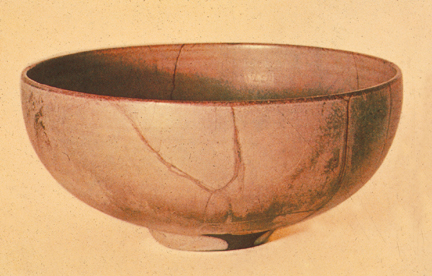Otto and Gertrud Natzler were potters in Vienna, Austria, who fled
the advance of the Nazis in 1938 and located themselves in Los Angeles.
They escaped with not much more than their kiln. They worked together, with
Gertrude doing the throwing and Otto, the glazing. Her forms are simple
and classic, with a concentration on bowls and vases, forms that were excellent
showcases for Otto's unusual glazes. He is an avid experimenter who is known
for keeping meticulous notes on his glaze tests. Such notes are essential,
as sometimes strange things happen during a kiln firing. The piece for example
is the result of an unusual occurrence. During a firing of his electric
kiln, the power was interrupted by an outage. When this happens, the potter
is helpless (unless he has a backup generator), and can only watch as the
kiln temperatures plummet. Otto, true to form, kept notes of what happened,
recording this temperature drop. The kiln had not reached maturation temperature,
but the glaze had begun to melt. When the power went off and the temperature
dropped, the surface of the glaze cooled and hardened and crazed (remember
the Song dynasty glaze surfaces). Then the power came back on, and Otto
decided to continue the firing to reach maturation temperature. When the
glaze remelted, the now fluid glaze flowed up between the fissures in the
crazed glaze surface, causing the fissures to move apart. This is the effect
seen here, and Otto would call this phenomenon 'melt fissures.' Since he
had taken accurate notes of the firing process, he was able to repeat this
effect by intentionally turning his kiln off at the right time of the firing,
and then turning it back on again. Gertrude has passed away and now Otto
continues his glaze experiments on his own slab built forms.

Melt Fissure Bowl, by Otto and Gertrude Natzler, Earthenware, 12.5" D., 1956


